Analyzing Talent Planning in Organizations: A Comprehensive Report
VerifiedAdded on 2022/08/11
|10
|1778
|25
Report
AI Summary
This report provides a comprehensive analysis of talent planning within organizations. It identifies and assesses factors affecting an organization's approach to attracting talent, including economic stability, workplace location, lack of training, and brand image. The report highlights the benefits of attracting and retaining a diverse workforce, such as increased production, innovation, and improved company culture. It also describes factors influencing recruitment and selection, including job image, the rate of unemployment, and business competition. Furthermore, the report outlines the benefits of various recruitment methods like employee referrals, social websites, and campus recruitment, alongside selection methods such as aptitude assessments, face-to-face interviews, and background checks. The report concludes by explaining the purposes of induction methods, including workplace culture awareness, avoiding compliance issues, and enhancing company reputation, and provides a detailed induction plan with timelines and responsibilities.
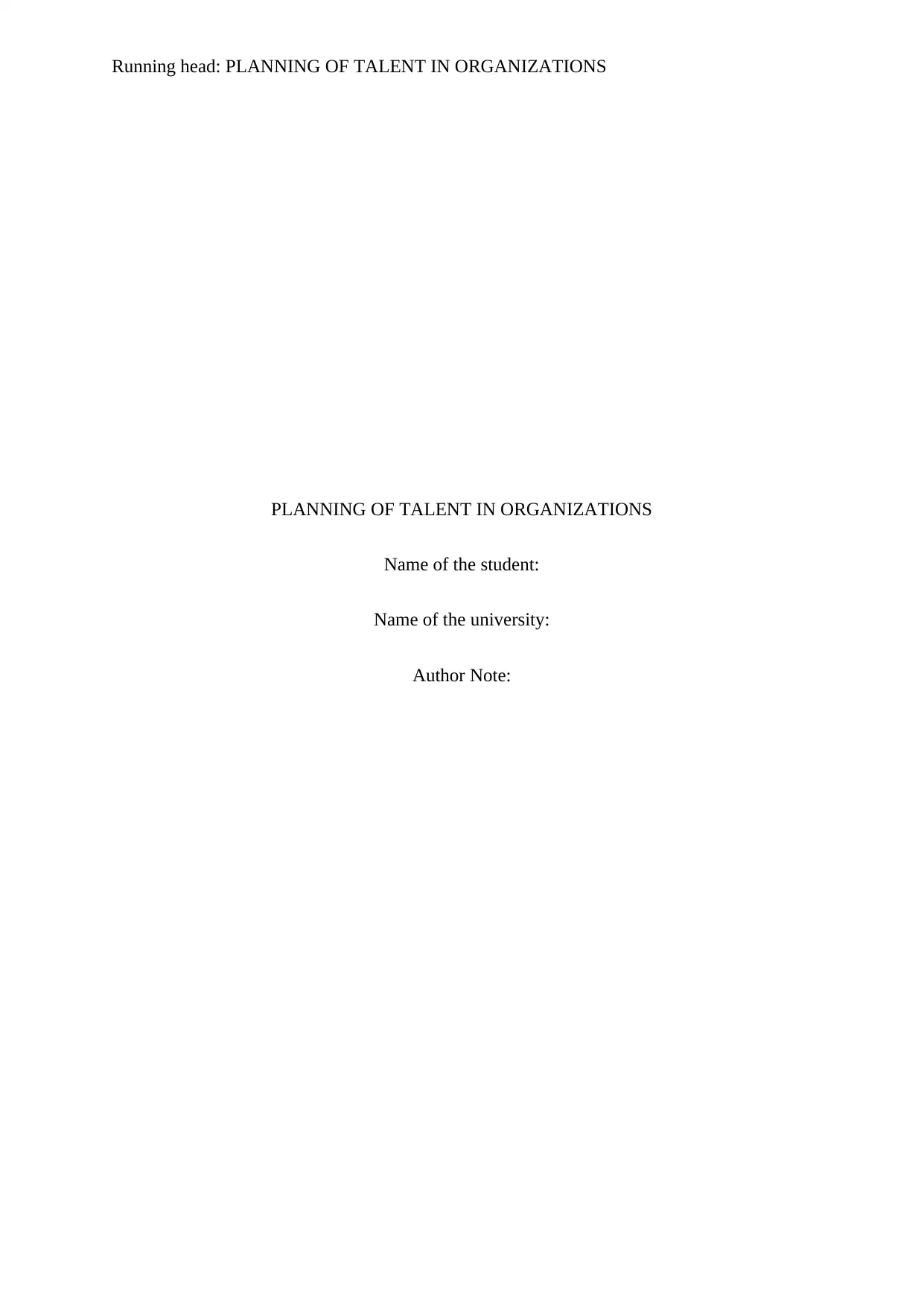
Running head: PLANNING OF TALENT IN ORGANIZATIONS
PLANNING OF TALENT IN ORGANIZATIONS
Name of the student:
Name of the university:
Author Note:
PLANNING OF TALENT IN ORGANIZATIONS
Name of the student:
Name of the university:
Author Note:
Paraphrase This Document
Need a fresh take? Get an instant paraphrase of this document with our AI Paraphraser
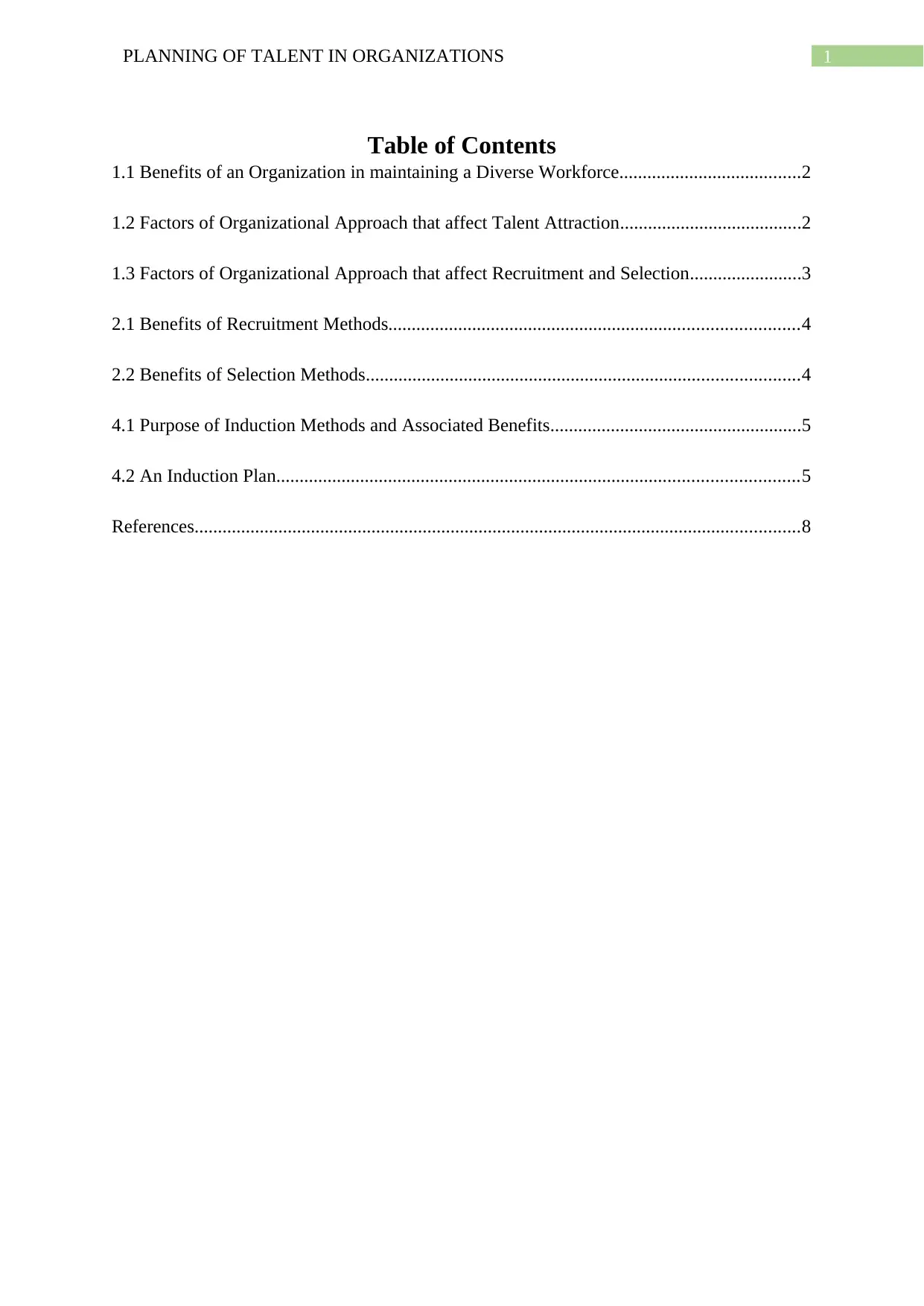
1PLANNING OF TALENT IN ORGANIZATIONS
Table of Contents
1.1 Benefits of an Organization in maintaining a Diverse Workforce.......................................2
1.2 Factors of Organizational Approach that affect Talent Attraction.......................................2
1.3 Factors of Organizational Approach that affect Recruitment and Selection........................3
2.1 Benefits of Recruitment Methods........................................................................................4
2.2 Benefits of Selection Methods.............................................................................................4
4.1 Purpose of Induction Methods and Associated Benefits......................................................5
4.2 An Induction Plan................................................................................................................5
References..................................................................................................................................8
Table of Contents
1.1 Benefits of an Organization in maintaining a Diverse Workforce.......................................2
1.2 Factors of Organizational Approach that affect Talent Attraction.......................................2
1.3 Factors of Organizational Approach that affect Recruitment and Selection........................3
2.1 Benefits of Recruitment Methods........................................................................................4
2.2 Benefits of Selection Methods.............................................................................................4
4.1 Purpose of Induction Methods and Associated Benefits......................................................5
4.2 An Induction Plan................................................................................................................5
References..................................................................................................................................8
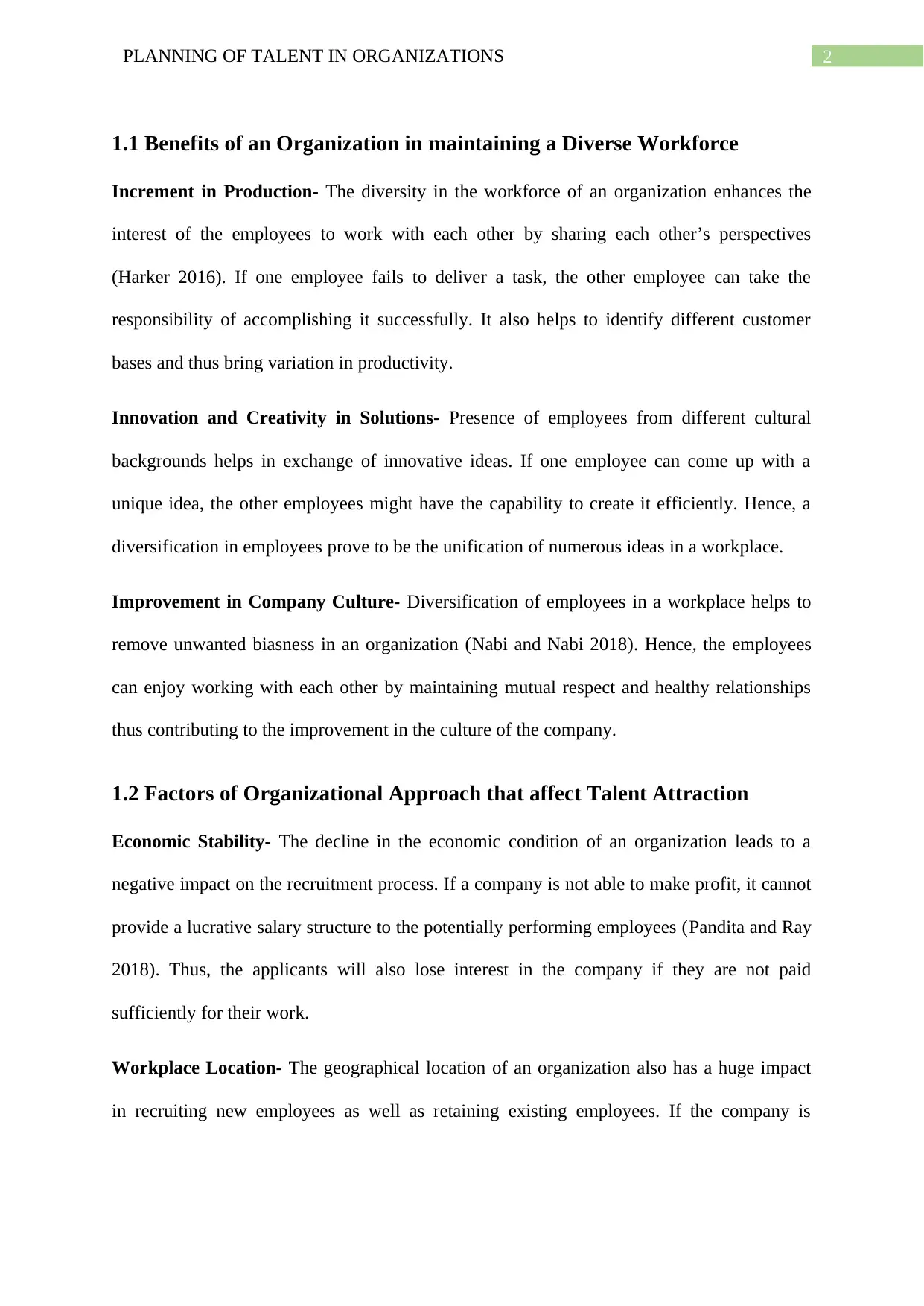
2PLANNING OF TALENT IN ORGANIZATIONS
1.1 Benefits of an Organization in maintaining a Diverse Workforce
Increment in Production- The diversity in the workforce of an organization enhances the
interest of the employees to work with each other by sharing each other’s perspectives
(Harker 2016). If one employee fails to deliver a task, the other employee can take the
responsibility of accomplishing it successfully. It also helps to identify different customer
bases and thus bring variation in productivity.
Innovation and Creativity in Solutions- Presence of employees from different cultural
backgrounds helps in exchange of innovative ideas. If one employee can come up with a
unique idea, the other employees might have the capability to create it efficiently. Hence, a
diversification in employees prove to be the unification of numerous ideas in a workplace.
Improvement in Company Culture- Diversification of employees in a workplace helps to
remove unwanted biasness in an organization (Nabi and Nabi 2018). Hence, the employees
can enjoy working with each other by maintaining mutual respect and healthy relationships
thus contributing to the improvement in the culture of the company.
1.2 Factors of Organizational Approach that affect Talent Attraction
Economic Stability- The decline in the economic condition of an organization leads to a
negative impact on the recruitment process. If a company is not able to make profit, it cannot
provide a lucrative salary structure to the potentially performing employees (Pandita and Ray
2018). Thus, the applicants will also lose interest in the company if they are not paid
sufficiently for their work.
Workplace Location- The geographical location of an organization also has a huge impact
in recruiting new employees as well as retaining existing employees. If the company is
1.1 Benefits of an Organization in maintaining a Diverse Workforce
Increment in Production- The diversity in the workforce of an organization enhances the
interest of the employees to work with each other by sharing each other’s perspectives
(Harker 2016). If one employee fails to deliver a task, the other employee can take the
responsibility of accomplishing it successfully. It also helps to identify different customer
bases and thus bring variation in productivity.
Innovation and Creativity in Solutions- Presence of employees from different cultural
backgrounds helps in exchange of innovative ideas. If one employee can come up with a
unique idea, the other employees might have the capability to create it efficiently. Hence, a
diversification in employees prove to be the unification of numerous ideas in a workplace.
Improvement in Company Culture- Diversification of employees in a workplace helps to
remove unwanted biasness in an organization (Nabi and Nabi 2018). Hence, the employees
can enjoy working with each other by maintaining mutual respect and healthy relationships
thus contributing to the improvement in the culture of the company.
1.2 Factors of Organizational Approach that affect Talent Attraction
Economic Stability- The decline in the economic condition of an organization leads to a
negative impact on the recruitment process. If a company is not able to make profit, it cannot
provide a lucrative salary structure to the potentially performing employees (Pandita and Ray
2018). Thus, the applicants will also lose interest in the company if they are not paid
sufficiently for their work.
Workplace Location- The geographical location of an organization also has a huge impact
in recruiting new employees as well as retaining existing employees. If the company is
⊘ This is a preview!⊘
Do you want full access?
Subscribe today to unlock all pages.

Trusted by 1+ million students worldwide
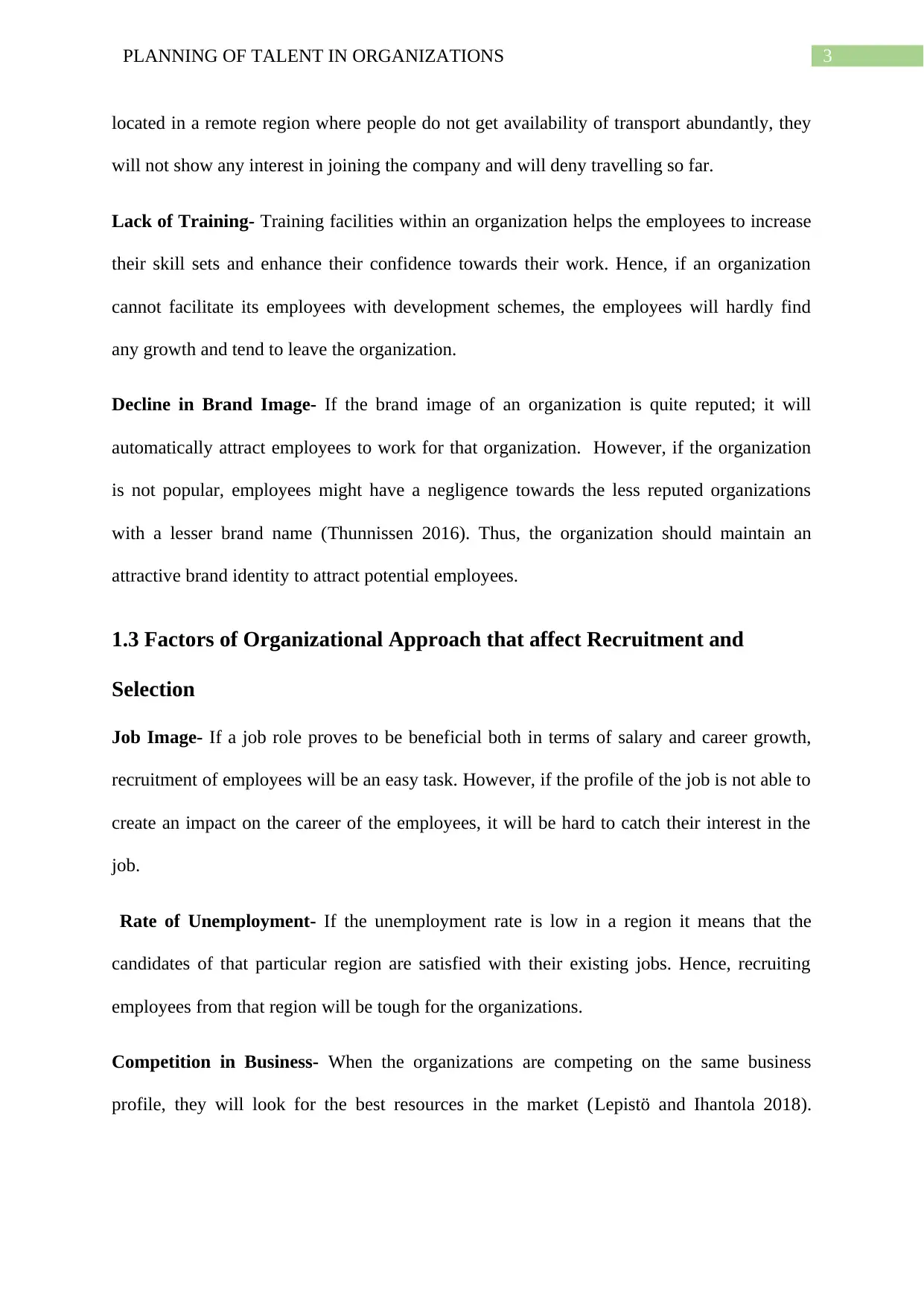
3PLANNING OF TALENT IN ORGANIZATIONS
located in a remote region where people do not get availability of transport abundantly, they
will not show any interest in joining the company and will deny travelling so far.
Lack of Training- Training facilities within an organization helps the employees to increase
their skill sets and enhance their confidence towards their work. Hence, if an organization
cannot facilitate its employees with development schemes, the employees will hardly find
any growth and tend to leave the organization.
Decline in Brand Image- If the brand image of an organization is quite reputed; it will
automatically attract employees to work for that organization. However, if the organization
is not popular, employees might have a negligence towards the less reputed organizations
with a lesser brand name (Thunnissen 2016). Thus, the organization should maintain an
attractive brand identity to attract potential employees.
1.3 Factors of Organizational Approach that affect Recruitment and
Selection
Job Image- If a job role proves to be beneficial both in terms of salary and career growth,
recruitment of employees will be an easy task. However, if the profile of the job is not able to
create an impact on the career of the employees, it will be hard to catch their interest in the
job.
Rate of Unemployment- If the unemployment rate is low in a region it means that the
candidates of that particular region are satisfied with their existing jobs. Hence, recruiting
employees from that region will be tough for the organizations.
Competition in Business- When the organizations are competing on the same business
profile, they will look for the best resources in the market (Lepistö and Ihantola 2018).
located in a remote region where people do not get availability of transport abundantly, they
will not show any interest in joining the company and will deny travelling so far.
Lack of Training- Training facilities within an organization helps the employees to increase
their skill sets and enhance their confidence towards their work. Hence, if an organization
cannot facilitate its employees with development schemes, the employees will hardly find
any growth and tend to leave the organization.
Decline in Brand Image- If the brand image of an organization is quite reputed; it will
automatically attract employees to work for that organization. However, if the organization
is not popular, employees might have a negligence towards the less reputed organizations
with a lesser brand name (Thunnissen 2016). Thus, the organization should maintain an
attractive brand identity to attract potential employees.
1.3 Factors of Organizational Approach that affect Recruitment and
Selection
Job Image- If a job role proves to be beneficial both in terms of salary and career growth,
recruitment of employees will be an easy task. However, if the profile of the job is not able to
create an impact on the career of the employees, it will be hard to catch their interest in the
job.
Rate of Unemployment- If the unemployment rate is low in a region it means that the
candidates of that particular region are satisfied with their existing jobs. Hence, recruiting
employees from that region will be tough for the organizations.
Competition in Business- When the organizations are competing on the same business
profile, they will look for the best resources in the market (Lepistö and Ihantola 2018).
Paraphrase This Document
Need a fresh take? Get an instant paraphrase of this document with our AI Paraphraser
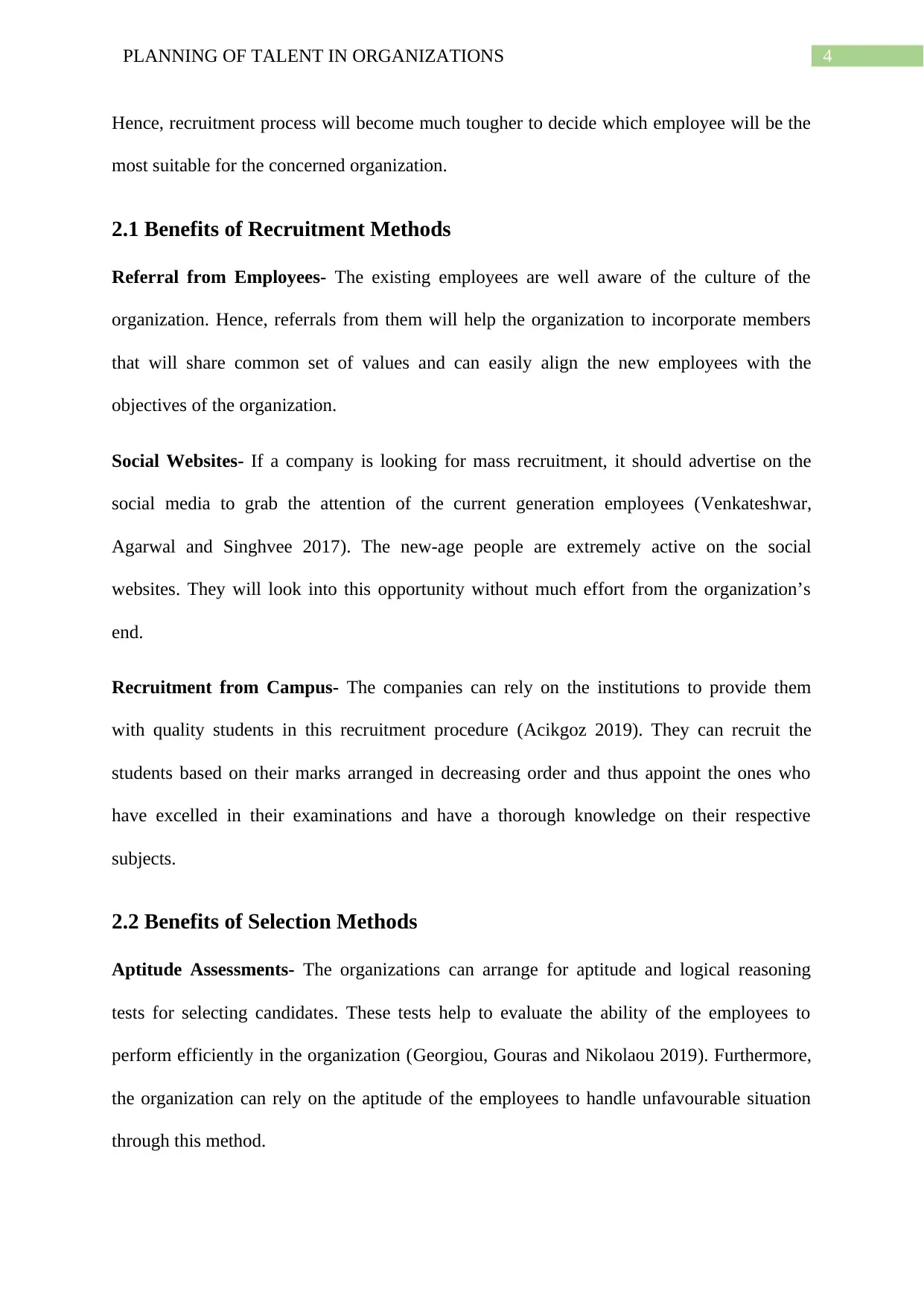
4PLANNING OF TALENT IN ORGANIZATIONS
Hence, recruitment process will become much tougher to decide which employee will be the
most suitable for the concerned organization.
2.1 Benefits of Recruitment Methods
Referral from Employees- The existing employees are well aware of the culture of the
organization. Hence, referrals from them will help the organization to incorporate members
that will share common set of values and can easily align the new employees with the
objectives of the organization.
Social Websites- If a company is looking for mass recruitment, it should advertise on the
social media to grab the attention of the current generation employees (Venkateshwar,
Agarwal and Singhvee 2017). The new-age people are extremely active on the social
websites. They will look into this opportunity without much effort from the organization’s
end.
Recruitment from Campus- The companies can rely on the institutions to provide them
with quality students in this recruitment procedure (Acikgoz 2019). They can recruit the
students based on their marks arranged in decreasing order and thus appoint the ones who
have excelled in their examinations and have a thorough knowledge on their respective
subjects.
2.2 Benefits of Selection Methods
Aptitude Assessments- The organizations can arrange for aptitude and logical reasoning
tests for selecting candidates. These tests help to evaluate the ability of the employees to
perform efficiently in the organization (Georgiou, Gouras and Nikolaou 2019). Furthermore,
the organization can rely on the aptitude of the employees to handle unfavourable situation
through this method.
Hence, recruitment process will become much tougher to decide which employee will be the
most suitable for the concerned organization.
2.1 Benefits of Recruitment Methods
Referral from Employees- The existing employees are well aware of the culture of the
organization. Hence, referrals from them will help the organization to incorporate members
that will share common set of values and can easily align the new employees with the
objectives of the organization.
Social Websites- If a company is looking for mass recruitment, it should advertise on the
social media to grab the attention of the current generation employees (Venkateshwar,
Agarwal and Singhvee 2017). The new-age people are extremely active on the social
websites. They will look into this opportunity without much effort from the organization’s
end.
Recruitment from Campus- The companies can rely on the institutions to provide them
with quality students in this recruitment procedure (Acikgoz 2019). They can recruit the
students based on their marks arranged in decreasing order and thus appoint the ones who
have excelled in their examinations and have a thorough knowledge on their respective
subjects.
2.2 Benefits of Selection Methods
Aptitude Assessments- The organizations can arrange for aptitude and logical reasoning
tests for selecting candidates. These tests help to evaluate the ability of the employees to
perform efficiently in the organization (Georgiou, Gouras and Nikolaou 2019). Furthermore,
the organization can rely on the aptitude of the employees to handle unfavourable situation
through this method.
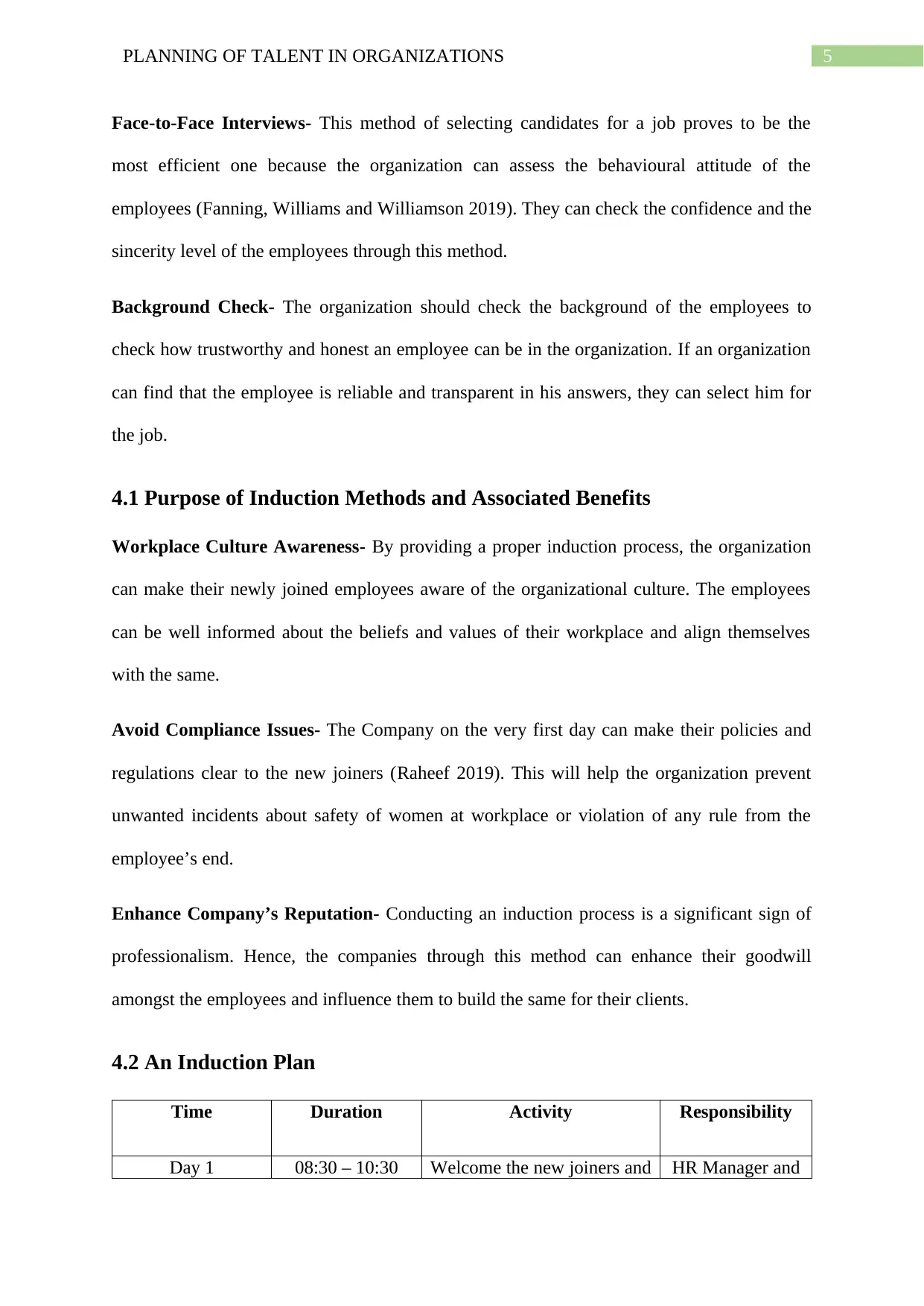
5PLANNING OF TALENT IN ORGANIZATIONS
Face-to-Face Interviews- This method of selecting candidates for a job proves to be the
most efficient one because the organization can assess the behavioural attitude of the
employees (Fanning, Williams and Williamson 2019). They can check the confidence and the
sincerity level of the employees through this method.
Background Check- The organization should check the background of the employees to
check how trustworthy and honest an employee can be in the organization. If an organization
can find that the employee is reliable and transparent in his answers, they can select him for
the job.
4.1 Purpose of Induction Methods and Associated Benefits
Workplace Culture Awareness- By providing a proper induction process, the organization
can make their newly joined employees aware of the organizational culture. The employees
can be well informed about the beliefs and values of their workplace and align themselves
with the same.
Avoid Compliance Issues- The Company on the very first day can make their policies and
regulations clear to the new joiners (Raheef 2019). This will help the organization prevent
unwanted incidents about safety of women at workplace or violation of any rule from the
employee’s end.
Enhance Company’s Reputation- Conducting an induction process is a significant sign of
professionalism. Hence, the companies through this method can enhance their goodwill
amongst the employees and influence them to build the same for their clients.
4.2 An Induction Plan
Time Duration Activity Responsibility
Day 1 08:30 – 10:30 Welcome the new joiners and HR Manager and
Face-to-Face Interviews- This method of selecting candidates for a job proves to be the
most efficient one because the organization can assess the behavioural attitude of the
employees (Fanning, Williams and Williamson 2019). They can check the confidence and the
sincerity level of the employees through this method.
Background Check- The organization should check the background of the employees to
check how trustworthy and honest an employee can be in the organization. If an organization
can find that the employee is reliable and transparent in his answers, they can select him for
the job.
4.1 Purpose of Induction Methods and Associated Benefits
Workplace Culture Awareness- By providing a proper induction process, the organization
can make their newly joined employees aware of the organizational culture. The employees
can be well informed about the beliefs and values of their workplace and align themselves
with the same.
Avoid Compliance Issues- The Company on the very first day can make their policies and
regulations clear to the new joiners (Raheef 2019). This will help the organization prevent
unwanted incidents about safety of women at workplace or violation of any rule from the
employee’s end.
Enhance Company’s Reputation- Conducting an induction process is a significant sign of
professionalism. Hence, the companies through this method can enhance their goodwill
amongst the employees and influence them to build the same for their clients.
4.2 An Induction Plan
Time Duration Activity Responsibility
Day 1 08:30 – 10:30 Welcome the new joiners and HR Manager and
⊘ This is a preview!⊘
Do you want full access?
Subscribe today to unlock all pages.

Trusted by 1+ million students worldwide
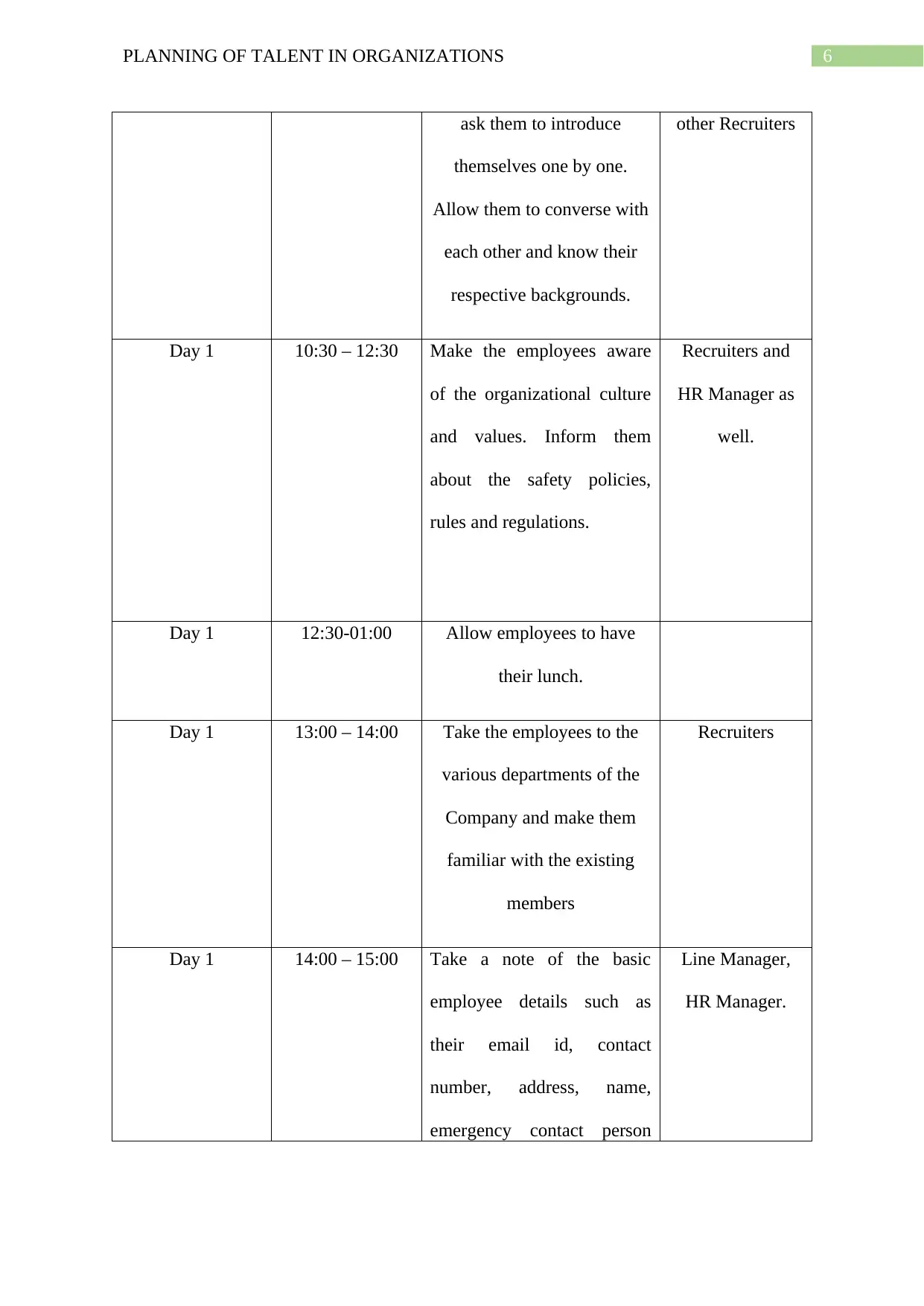
6PLANNING OF TALENT IN ORGANIZATIONS
ask them to introduce
themselves one by one.
Allow them to converse with
each other and know their
respective backgrounds.
other Recruiters
Day 1 10:30 – 12:30 Make the employees aware
of the organizational culture
and values. Inform them
about the safety policies,
rules and regulations.
Recruiters and
HR Manager as
well.
Day 1 12:30-01:00 Allow employees to have
their lunch.
Day 1 13:00 – 14:00 Take the employees to the
various departments of the
Company and make them
familiar with the existing
members
Recruiters
Day 1 14:00 – 15:00 Take a note of the basic
employee details such as
their email id, contact
number, address, name,
emergency contact person
Line Manager,
HR Manager.
ask them to introduce
themselves one by one.
Allow them to converse with
each other and know their
respective backgrounds.
other Recruiters
Day 1 10:30 – 12:30 Make the employees aware
of the organizational culture
and values. Inform them
about the safety policies,
rules and regulations.
Recruiters and
HR Manager as
well.
Day 1 12:30-01:00 Allow employees to have
their lunch.
Day 1 13:00 – 14:00 Take the employees to the
various departments of the
Company and make them
familiar with the existing
members
Recruiters
Day 1 14:00 – 15:00 Take a note of the basic
employee details such as
their email id, contact
number, address, name,
emergency contact person
Line Manager,
HR Manager.
Paraphrase This Document
Need a fresh take? Get an instant paraphrase of this document with our AI Paraphraser
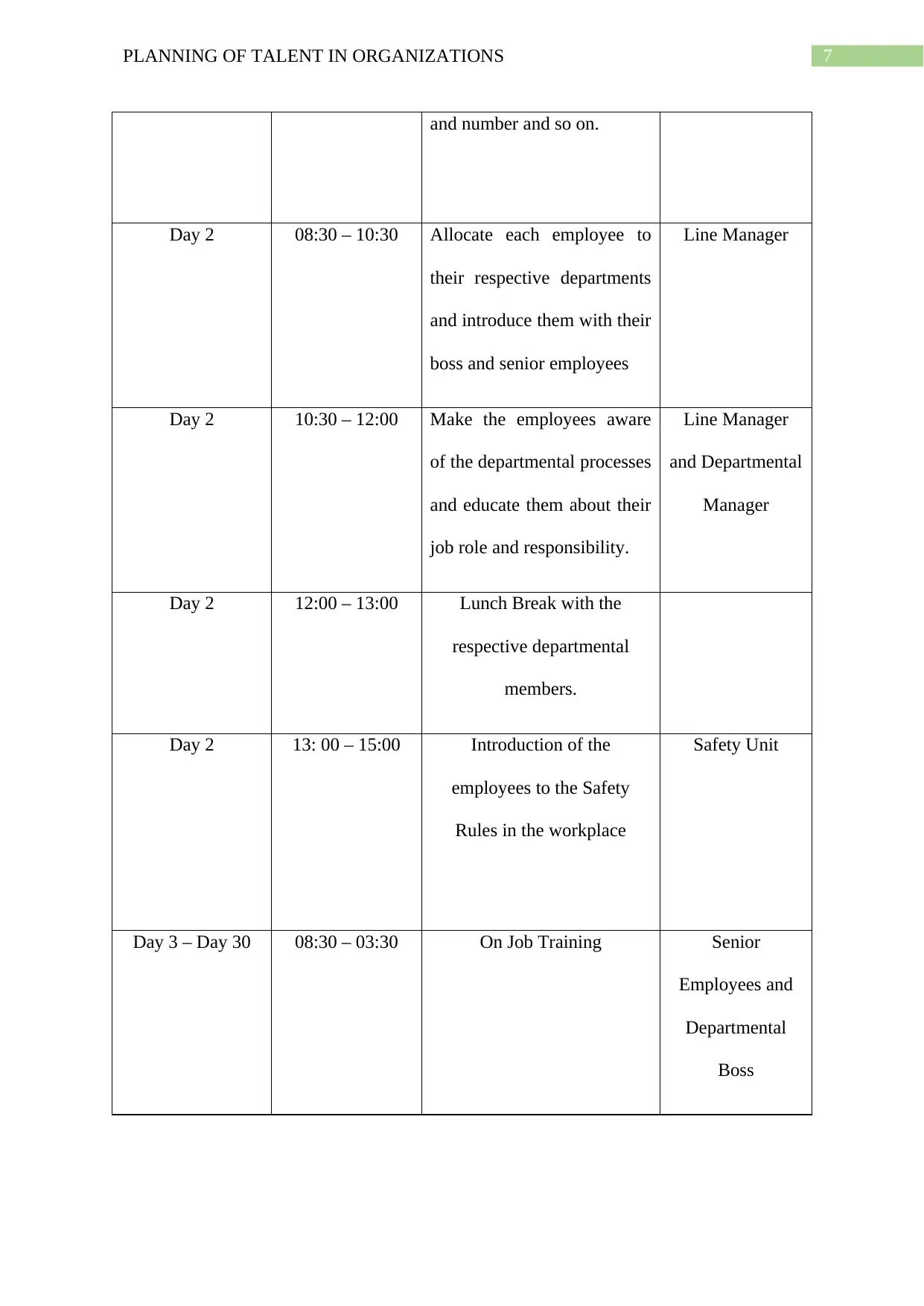
7PLANNING OF TALENT IN ORGANIZATIONS
and number and so on.
Day 2 08:30 – 10:30 Allocate each employee to
their respective departments
and introduce them with their
boss and senior employees
Line Manager
Day 2 10:30 – 12:00 Make the employees aware
of the departmental processes
and educate them about their
job role and responsibility.
Line Manager
and Departmental
Manager
Day 2 12:00 – 13:00 Lunch Break with the
respective departmental
members.
Day 2 13: 00 – 15:00 Introduction of the
employees to the Safety
Rules in the workplace
Safety Unit
Day 3 – Day 30 08:30 – 03:30 On Job Training Senior
Employees and
Departmental
Boss
and number and so on.
Day 2 08:30 – 10:30 Allocate each employee to
their respective departments
and introduce them with their
boss and senior employees
Line Manager
Day 2 10:30 – 12:00 Make the employees aware
of the departmental processes
and educate them about their
job role and responsibility.
Line Manager
and Departmental
Manager
Day 2 12:00 – 13:00 Lunch Break with the
respective departmental
members.
Day 2 13: 00 – 15:00 Introduction of the
employees to the Safety
Rules in the workplace
Safety Unit
Day 3 – Day 30 08:30 – 03:30 On Job Training Senior
Employees and
Departmental
Boss

8PLANNING OF TALENT IN ORGANIZATIONS
⊘ This is a preview!⊘
Do you want full access?
Subscribe today to unlock all pages.

Trusted by 1+ million students worldwide
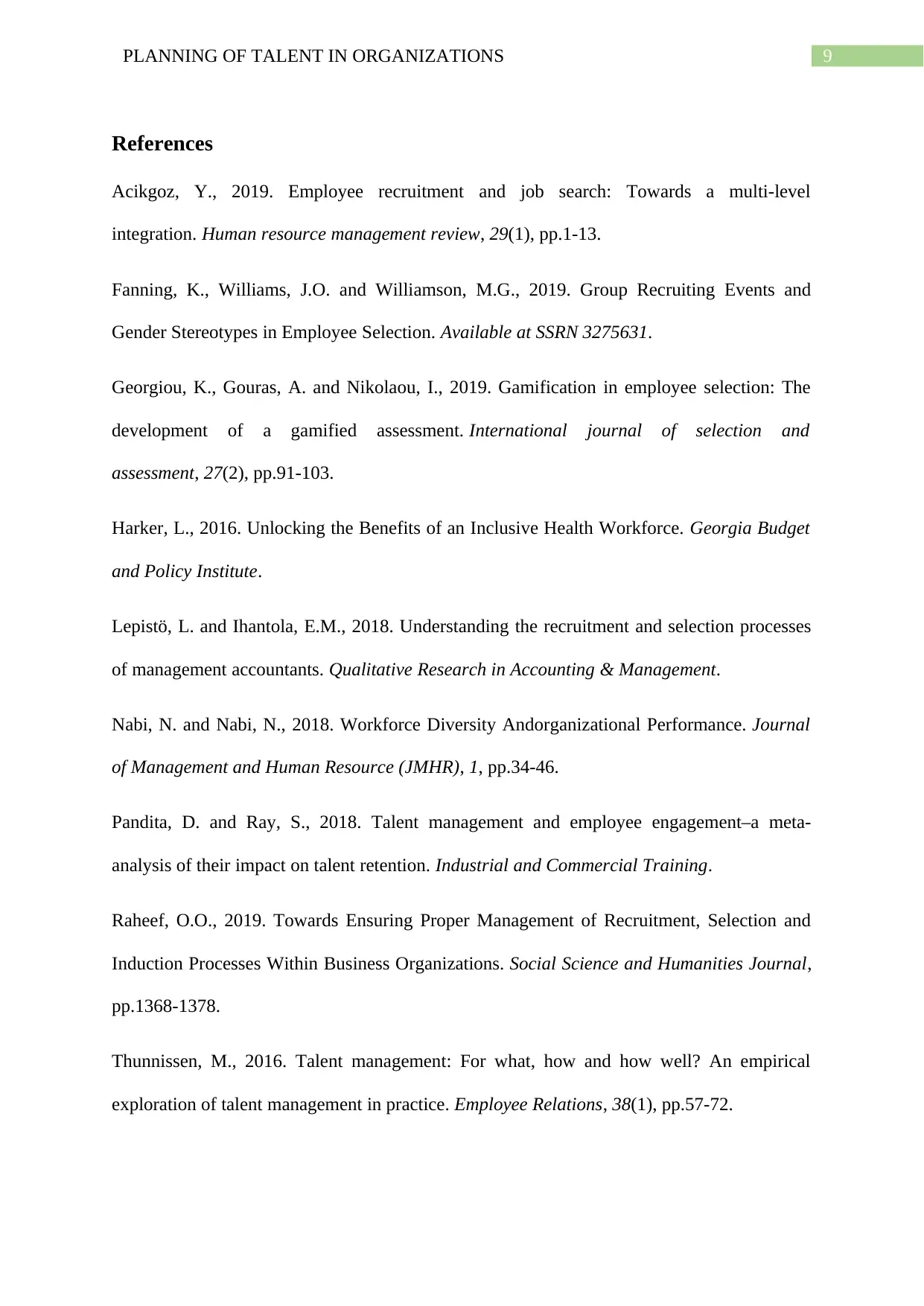
9PLANNING OF TALENT IN ORGANIZATIONS
References
Acikgoz, Y., 2019. Employee recruitment and job search: Towards a multi-level
integration. Human resource management review, 29(1), pp.1-13.
Fanning, K., Williams, J.O. and Williamson, M.G., 2019. Group Recruiting Events and
Gender Stereotypes in Employee Selection. Available at SSRN 3275631.
Georgiou, K., Gouras, A. and Nikolaou, I., 2019. Gamification in employee selection: The
development of a gamified assessment. International journal of selection and
assessment, 27(2), pp.91-103.
Harker, L., 2016. Unlocking the Benefits of an Inclusive Health Workforce. Georgia Budget
and Policy Institute.
Lepistö, L. and Ihantola, E.M., 2018. Understanding the recruitment and selection processes
of management accountants. Qualitative Research in Accounting & Management.
Nabi, N. and Nabi, N., 2018. Workforce Diversity Andorganizational Performance. Journal
of Management and Human Resource (JMHR), 1, pp.34-46.
Pandita, D. and Ray, S., 2018. Talent management and employee engagement–a meta-
analysis of their impact on talent retention. Industrial and Commercial Training.
Raheef, O.O., 2019. Towards Ensuring Proper Management of Recruitment, Selection and
Induction Processes Within Business Organizations. Social Science and Humanities Journal,
pp.1368-1378.
Thunnissen, M., 2016. Talent management: For what, how and how well? An empirical
exploration of talent management in practice. Employee Relations, 38(1), pp.57-72.
References
Acikgoz, Y., 2019. Employee recruitment and job search: Towards a multi-level
integration. Human resource management review, 29(1), pp.1-13.
Fanning, K., Williams, J.O. and Williamson, M.G., 2019. Group Recruiting Events and
Gender Stereotypes in Employee Selection. Available at SSRN 3275631.
Georgiou, K., Gouras, A. and Nikolaou, I., 2019. Gamification in employee selection: The
development of a gamified assessment. International journal of selection and
assessment, 27(2), pp.91-103.
Harker, L., 2016. Unlocking the Benefits of an Inclusive Health Workforce. Georgia Budget
and Policy Institute.
Lepistö, L. and Ihantola, E.M., 2018. Understanding the recruitment and selection processes
of management accountants. Qualitative Research in Accounting & Management.
Nabi, N. and Nabi, N., 2018. Workforce Diversity Andorganizational Performance. Journal
of Management and Human Resource (JMHR), 1, pp.34-46.
Pandita, D. and Ray, S., 2018. Talent management and employee engagement–a meta-
analysis of their impact on talent retention. Industrial and Commercial Training.
Raheef, O.O., 2019. Towards Ensuring Proper Management of Recruitment, Selection and
Induction Processes Within Business Organizations. Social Science and Humanities Journal,
pp.1368-1378.
Thunnissen, M., 2016. Talent management: For what, how and how well? An empirical
exploration of talent management in practice. Employee Relations, 38(1), pp.57-72.
1 out of 10
Related Documents
Your All-in-One AI-Powered Toolkit for Academic Success.
+13062052269
info@desklib.com
Available 24*7 on WhatsApp / Email
![[object Object]](/_next/static/media/star-bottom.7253800d.svg)
Unlock your academic potential
Copyright © 2020–2025 A2Z Services. All Rights Reserved. Developed and managed by ZUCOL.




